One of the biggest problems besetting electric vehicles is their cost. It doesn’t matter how much you like something if you can’t afford it – and it doesn’t do much good to sell things most people can’t afford to buy.
Like the Mercedes EQS I test drove back in December.
It is essentially an electric version of the Mercedes S-Class, which is Mercedes’ top-of-the-line, full-size sedan. The EQS is, accordingly, a very pricey sedan – $104,400 to start. This means Mercedes won’t sell very many of them, irrespective of its appeal. Because there are only so many who can afford to spend six figures on a car. 
Any car – electric or not.
Enter the EQE – which is a smaller take on the EQS that comes standard with a less forbidding price tag that puts it within reach of more people who might like to own it.
But more isn’t many – and that may be this car’s biggest problem, not its range or the time it takes to recharge.
What It Is
The EQE is an electric luxury sedan that’s very similar to the one-step-larger EQS in terms of its looks, layout and features but is mid-sized rather than full-sized.
It is also priced at $74,900 to start for the rear-drive EQE 350+ as opposed to $104,400 for the EQS 450+.
An EQE 350+ with with dual motors and all wheel-drive stickers for $77,900.
The top-of-the-line EQE 500 comes standard with AWD and the electric-car equivalent of 402 horsepower (vs. 288 in the EQE 350).
Claimed range on a full charge is 305 miles for the EQE 350+ and 260 for the more power-consumptive (but much quicker) EQE 500.
What’s New For 2023
The EQE is a brand-new model and Mercedes’ second electric car entrant in the United States.
What’s Good
Cost $30k less to start than the EQS and is very similar, just a little smaller.
EQE 350 is extremely responsive.
EQE 500 is extremely quick.
What’s Not So Good
Still very expensive; a gas-engined (and otherwise comparable) E-Class sedan can be bought for about $20k less.
EQE 500’s best-case of range of 260 miles limits how far you can go – before you have to wait.
Unlike the EQS, the EQE is not a hatchback and so it only has a 15.1 cubic foot trunk (vs. the EQS’ 63 total cubic feet of cargo capacity).
“Under the hood” is becoming kind of like horsepower – in that both words have their roots in the past. “Horsepower” deriving from the era before there were cars and “under the hood” going back to the time when cars had engines.
Electric motors are also under there, of course – and sometimes out back, too (if the vehicle is AWD). But you often can’t see either and the area is often devoted to storage space. The battery that stores power for the motor(s) is also unseen; it is usually laid out in general congruity with the floorpan, to spread out its weight – so that the vehicles isn’t excessively nose or tail heavy.
Anyway, this EV comes standard (in the EQE 350+) with a 90.6 kilowatt-hour battery pack that powers a single electric motor that produces the engine-equivalent of 288 horsepower and 391 ft.-lbs. of torque. As in most EVs, there is no transmission because the EQE’s motot directly drives the (rear) wheels.
So equipped, the EQE 350+ can get to 60 in about 5.6 seconds, which is about the same as the mid-sized E350 sedan and remarkable given the EQE weighs almost a ton more. The curb weight of the E350 is 3,718 lbs. vs. a staggering 5,424 lbs. for the EQE – almost all of which is the batteries, which are necessary to get this rig to 60 equivalently.
And to give it 305 miles of fully charged range.
However, an E350 has a city range of 400 miles – and 539 miles on the highway. It can also be “fully recharged” – to use EV lingo – in less than five minutes whereas the “fastest” the EQE can be partially recharged – to 80 percent – using commercial-strength DC “fast” chargers – is about 30 minutes.
The “partially charged” is important to bear in mind because it means that even at a “fast” charger, you leave with 20 percent less charge than the fully-charged capacity. This amounts to 61 less miles of range than than the fully charged 305 miles of range you cannot get at a “fast” charger, without waiting a lot longer than 30 minutes (it is necessary to slow the rate of charge after 80 percent to avoid risking damage to the battery). To get to full charge means waiting closer to an hour – at a “fast” charger. It’s either that or get back on the road with 244 miles of range.
In the more potent EQE 500, the loss of 20 percent (or rather, not-gained) charge would mean leaving the “fast” charger with 208 miles of range, having sacrificed 52 of the maximum 260 miles in order to get back on the road in less than an hour.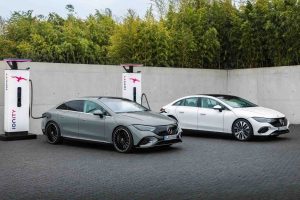
But your compensation for that is 0-60 in 4.5 seconds.
Like all EVs, you can also recharge at home. Just not “fast.” The very high DC voltage needed to do that isn’t available at home, where the most you’ve got is 240V of AC current, assuming you have an extra dryer-type outlet within range of your cord. If not, it will be necessary to have an electrician come out to wire one up for you.
Mercedes says either version of the EQE can be fully recharged on “Level II” – that is 240V AC current – in about 9.5 hours.
On The Road
When many of us were kids, we watched the Jetsons, which was a cartoon about the future from the perspective of the ’60s. George Jetson flew in a car that was powered by something that wasn’t an engine, that made futuristic sounds.
The EQE doesn’t fly – in the air – but it does make futuristic sounds that sound a lot like George Jetson’s flying car. A kind of beeee beeee beeee beeee beeep! that increases in intensity the faster you accelerate. It is not the sound of the motors – they are silent. It is the sound of something, which EVs would otherwise lack. People are used to hearing the roar of an engine when you floor it, of the revs building – and the transmission shifting. EVs are by nature as silent as an express elevator, which is desirable in a commercial context but not desirable in a product that people want to feel an emotional attachment to, especially if they are paying Mercedes money for the experience.
Hence the sound generated (in Sport mode) when you put the pedal to the metal.
There is also an eery-ethereal UFO kind of sound when you first get in, before you even take it for a spin. This is accentuated by eery, UFO-esque glowing LED lights tracing lines from door panel to door panel, across the dash – and the glowing array of LCD displays for the main gauge cluster and infotainment system. It makes you feel like Data at the helm of the Enterprise.
A feeling that is further enhanced when your Inner Picard says, make it so – and the Benz goes. It does not fly, per se – but it feels as if it might. The thrust of powerful electric motors and the immediacy of direct drive is a lot like the feel of a jet aircraft on its take-off roll. Speed just builds, without any sense of slowing down along the way.
You will not be displeased with the get-going capability of this Mercedes. Nor with the ride, which is as serenely quiet and smooth as the delivery of all that power. Even the handling is good, which is remarkable given how heavy this thing is. With two people on board, this mid-sized Mercedes will weigh almost three tons. That is a lot of weight to keep under control. Mercedes chassis engineers have done a fine job of that. The EQE does not wallow, dive or roll like the whale it weighs almost as much as it does.
The chief driving deficit here – as always, with all EVs – is that you start out with the equivalent of a half a tank of gas, which is about all the energy that an EV’s battery pack can store. This is why even the longest-range EVs don’t have that much range. And this leads to the second deficit, which is the more frequent need to stop for “fuel” – electricity, in this case.
And then the third deficit, which is the wait to “refuel,” even at a “fast” charger.
Another thing to know before you buy an EV is that actual vs. indicated range can vary, sometimes as much as 10 or 20 percent and to some extent because of factors you have no control over, such as the weather. EVs don’t like extremes of cold – or hot – which saps range directly (reduced battery efficiency) and also by use of necessary electrically powered accessories, such as the AC and heater/defroster.
Your driving style also matters – a lot. If you drive gently, accelerating moderately, keeping your speed down, you might be able to get the advertised range out of an EV – assuming it’s not too cold or hot out. But that sets up a paradox, as regards high-performance/luxury EVs, including this Mercedes:
Of course, the fact that’s available to use – when you need to or just want to – is probably the point. But it will cost you. In terms of rapidly diminishing charge (and so, range). But it might not be an issue for you if your drives are mostly within range – or you have the time to recharge.
You can choose a rear axle steering set-up (in the EQE 500) that reduces the turning circle at low speeds – but the car as it comes isn’t difficult to maneuver at all.
At The Curb
The EQE looks so much like the EQS that you almost need to park them side-by-side to tell the difference.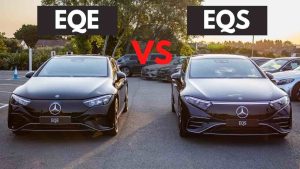
But there are differences.
One is simply in terms of length. The EQS is just shy of a foot longer (207.3 inches) than the EQE (196.9 inches). Another is that even though the two have very similar “coupe-like” styling, the EQE has a trunk, like a sedan, while the EQS has a rear hatchback – which leads to a big difference in terms of cargo capacity.
The EQE’s trunk offers 15.1 cubic feet of available capacity, which is more than the mid-sized E-Class sedan has (13.1) cubic feet). But – courtesy of its rear hatch – the EQS has much more than both of them, as well as more versatility. Behind the seats, the bigger Benz has 22 cubic feet of cargo space – which is more than its S-Class sedan sibling – and if you fold the rear seats forward you can open up the entirety of the car’s interior from the driver’s seat rearward, creating 63 cubic feet of available cargo-carrying space.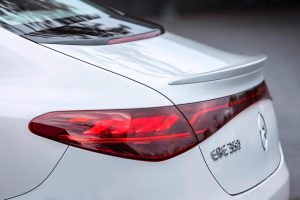
Electric or not, the hatchback layout makes a car a lot more practical – and more competitive with crossovers and SUVs.
Another difference is inside. The EQE has a tablet-style LCD screen for the dash complemented by another (larger) one built into the center stack. The EQS has a “one piece” LCD screen that covers most of the dashboard facing the driver and front seat passenger. Both share a common display theme/operation, including a “tach” to the right of the speedometer that displays how much power your right foot is summoning, rather than engine rpm.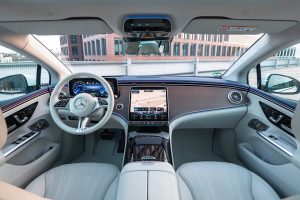
The secondary LCD cluster is the interface for the various apps and other functions, including EV-specific things such as charging parameters. You can “ask” the car to do various things – such as change the radio station, for instance – by saying Hey, Mercedes – and then asking it to do whatever it is you’d like the car to do.
Both the EQE and the EQS have LED interior lighting embedded all around the interior’s perimeter and that plus the glow of the display screens accompanied by the futuristic, UFO-like sounds makes it feel as though you are driving one.
If you drove this unit onto the base at area 51 in 1980, they’d probably have taken you to their leader.
One disappointing thing about the EQE 500 – which is an almost $90k car – is that it does not come standard with massaging seats. This is a significant omission in a car of this stature. They can be ordered as optional equipment – and for just $1,100 – which is a small sum in this scheme of things and begs the question as to why Mercedes doesn’t just include them? Well, it is probably for the same reason that a heated steering wheel and heated rear seats and heated windshield wipers are also optional. They all burn power – that is, electricity – and the use of these electrically-powered accessories will reduce the car’s range.
The Bottom Line
If you like the EQS but can’t quite swing a six-figure EV, here’s an EV that might be more within your range.
. . .
If you like what you’ve found here please consider supporting EPautos.
We depend on you to keep the wheels turning!
Our donate button is here.
If you prefer not to use PayPal, our mailing address is:
EPautos
721 Hummingbird Lane SE
Copper Hill, VA 24079
PS: Get an EPautos magnet or sticker or coaster in return for a $20 or more one-time donation or a $10 or more monthly recurring donation. (Please be sure to tell us you want a magnet or sticker or coaster – and also, provide an address, so we know where to mail the thing!)
My eBook about car buying (new and used) is also available for your favorite price – free! Click here. If that fails, email me at EPeters952@yahoo.com and I will send you a copy directly!


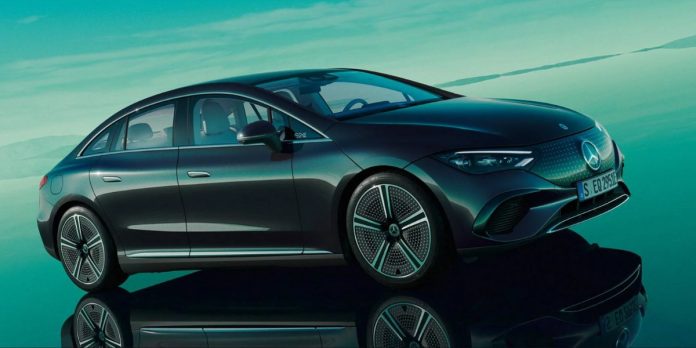

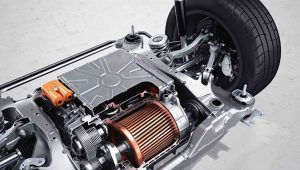
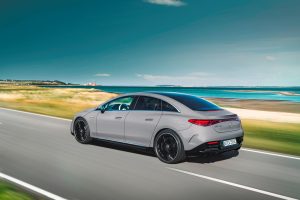
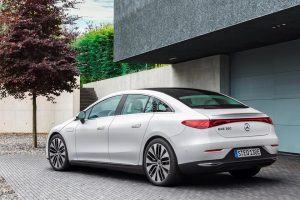








Mercedes EV with a 90 kwh battery:
under ideal conditions …..but at top speed ……a mercedes EV used 90 kwh of electricity in 100 miles ….the entire charge in 100 miles…
EV’ fuel economy drops way down at over 60 mph..so they sit in the right lane…probably left lane going slow…scared shitless……EV’s are useless junk….
In ideal conditions a mercerdes EV used 49.6 kwh per 100 miles = 1.42 gallons of gas at the wall plug = reality 5.7 gallons of fuel burnt at the power plant to make the electricity = 17.5 real non bullshit mpg…so range = about 200 miles, but you can only use 60% of battery capacity so range = 120 miles
but…….. under ideal conditions …..but at top speed ……a mercedes EV used 90 kwh of electricity in 100 miles which = 3 gallons of gas at the wall plug….back at the power station reality = 12 gallons burnt = 8.3 mpg…….so range = about 100 miles, but you can only use 60% of battery capacity so range = 60 miles
Under other not ideal conditions the EV efficiency drops a lot, might use twice as much energy to go 100 miles. Using the electric heater, heated seats, AC, stereo, and the rear defroster and wipers, or towing something in an EV reduces range too.
In very cold conditions the battery range can drop 50%. so same result… 90 kwh of electricity used in 100 miles which = 3 gallons of gas at the wall plug….back at the power station reality = 12 gallons burnt = 8.3 mpg……so range = about 100 miles, but you can only use 60% of battery capacity so range = 60 miles
but what if you go top speed, flat out in very cold weather what would it be?….lol….what if you are towing something?….lol
travelling 100 miles in a diesel getting 73.5 mpg U.S = 1.36 gallons for 100 miles, no need to waste all that fuel.
diesel fuel cost per 100 miles = 1.36 gallons @ $4.00 per gallon = $5.44
mercedes EV fuel cost per 100 miles = 49.4 kwh @ $0.40 = $19.40
EV fuel savings…hahaha
There is an additional cost for the EV owner: the tesla $22,000 battery is used up, worn out in 100,000 miles. this works out to $22.00 per 100 miles it is costing you for the battery.
mercedes EV fuel cost per 100 miles = 49.4 kwh @ $0.40 = $19.40…plus $22.00 for the battery use = $41.40….lol
the diesel owner paid $5.44 to go 100 miles….lol
EV’s are very expensive to own.
Thermal efficiency of power plants using coal, petroleum, natural gas or nuclear fuel and converting it to electricity are around 33% efficiency, natural gas is around 40%. Then there is average 6% loss in transmission, then there is a 5% loss in the charger, another 5% loss in the inverter, the electric motor is 90% efficient so another 10% loss before turning the electricity into mechanical power at the wheels.
33% – 6% – 5% – 5% – 10% = 25% efficiency for EV’s.
(under not ideal conditions it might be 12% efficient).
An Ev is 25% efficient in turning original source of energy, petroleum in this example into mechanical energy to push the car down the road.
ATTENTION….On a race track driven at ten tenths a tesla used 80 miles range in 8 miles, a 90% drop in range, not 50% driven fast EV’s get very bad fuel economy…….
burning 5.7 gallons of fuel to go 100 miles is cleaner, safer, less wasteful then burning 1.36 gallons of fuel?
Why are they pushing EV’s? They use twice the fuel so pollute twice as much…
They advertise EV’s getting 102 mpg….they should be sued, it is impossible using the technology they use, it is another huge lie….
(because they quote mpg at the wall plug, before the wall plug fairies and unicorns make the electricity….lol)
The switch to EV’s has nothing to do with fuel economy or less pollution it is all about control and limiting/stopping mobility.
https://www.youtube.com/watch?v=6BSdq-MpPdg&t=113s
For charging at home, adding another (charging) ‘device’ can be avoided. I think most people are familar with the regular 120 V outlet (Nema 5-15 or 5-20) which will charge very slowly (4 to 6 miles per hour). The charging rate can be doubled with a fairly low cost modification. There are outlets available that incorporate a Nema 6-20 outlet. The 6-20 is a 240 V outlet. These outlets fit in a regular wall box and depending on the wiring of your garage may just involve an outlet swap. If you don’t posess the knowledge of course consult an electrician. Sans electrician it’s a $20 job.
https://www.leviton.com/en/products/8400-i
Tesla include a 6-20 plug in their mobile charging kit. That doubles the chaging rate to 8 to 12 miles per hour
Someone could build a fairly nice Sprinter based limousine for that much and still have some money left over for buying an ESG friendly investment fund to assuage their guilt.
‘You can “ask” the car to do various things … by saying “Hey, Mercedes.” ‘ — eric
One wonders how the real-life Mercedes would feel about being virtually reincarnated 120 years later:
‘Mercédès Adrienne Ramona Manuela Jellinek was the daughter of Austrian automobile entrepreneur Emil Jellinek and his first wife Rachel Goggmann Cenrobert. She was born in Vienna. She is best known for her father having Daimler-Motoren-Gesellschaft’s line of Mercedes cars named after her, beginning with the Mercedes 35 hp model of 1901.
‘Her father hung a large picture of her at the 1902 Paris Automobile exhibition. He even legally changed his name to Jellinek-Mercedes in 1903 after Daimler-Motoren-Gesellschaft registered Mercedes as a trademark in 1902. Mercedes is a Spanish feminine name meaning mercy.
‘She played music and had a good soprano voice. She never shared her father’s passion for automobiles.’ — Wikipedia
Two comments:
1. Emil Jellinek amending his surname to Jellinek-Mercedes in honor of a new car brand sounds pretty hard-core for the time. These days, of course, he’d get it tattooed on his chest.
2. Despite her Spanish given name, Mercedes seems to have been [Sephardic?] Jewish, since Wikipedia mentions that her grandfather was the chief rabbi of Vienna.
I wrote this April 1 article on EVs for my climate science and engineering blog. This is an edited, shorter version of the original, which is at the link below. I hope some readers appreciate it here. I am a graduate of the Academy of Lame Comedy, voted most likely to bomb at a comedy club:
I’m selling two items and one service that many people can not live without:
(1) For those who live in blue neighborhoods, and want to fit in by purchasing an electric car, but can’t afford one: This chrome plated plastic emblem can be attached to the rear of your gasoline engine car, with built on easy to mount self-adhesive strips:
ELECTRIC
radio
(2) For those people who want virtue signal about climate change, but can’t afford an electric vehicle, and don’t want to pretend their gasoline engine car is an electric vehicle, what you need is a good heart tugging bumper sticker, which I am offering for only $5:
CLIMATE CHANGE KILLED MY DOG
(3) Let’s say you spent a huge amount of money to buy an electric vehicle and then found out it is worthless for long trips and doesn’t get far on a charge in the winter. You wish you had purchased a much less expensive gasoline engine car. Now you can “lose” that awful EV, collect a lot of car insurance money, then buy a gasoline engine car, and have tens of thousands of dollars left over to spend on anything fun (not on an electric car, that’s for sure):
The Electric Vehicle Relocation Service
will make your EV ‘disappear’, and no one will ever see it again. The price is $800 per EV “relocation”, and this will be the best investment you will ever make: Contact the CEO to make a reservation (next reservation available in six months):
Electric Vehicle Relocation Services, Inc.
Walter “I didn’t do it” Washington
Suite 34
Cellblock B
Jacksom State Prison
Jacson, Michigan 49201
$800 cash or money orders only
https://honestclimatescience.blogspot.com/2023/04/climate-science-and-energy-merchandise.html
Hi Richard,
The other day, I took the EQE to go grocery shopping. After I parked it, I was walking toward the store when I noticed a Chrysler 200 parked farther down the lane. I was astonished – and depressed – by how much this near $100k EV resembled a $26k shape from the not-so-distant past.
I was going to comment on the styling of both Mercedes EVs pictured in the article, but I am no expert on styling. So I asked the stylish wife, and she told me exactly what she said about Lincolns before their sales faltered: “They don’t look like luxury cars to me”.
Maybe the C-pillar is unusual. To me, it looks like a Tesla with a Mercedes emblem on the front.
The photographs of the batteries and motor were the best cutaways I’ve seen so far.
I wonder if passengers found the front passenger seat to be cramped — it seemed like the IP and door panel took up more space than necessary. Try sitting in the passenger seat if you haven’t already done that.
This long-time audiophile watched the video and listened to the fake motor sounds. Probably very distorted by my tiny computer speakers with minimal bass output.
I would feel like a dork driving an expensive car that made those obviously fake motor sounds. Like some boy riding on a bicycle using a clothespin on the front fork, holding a playing card to brush against the spokes of the front wheel, pretending he was driving on a real motorcycle.
I wouldn’t mind a Ferrari engine fake sound in my EV, if I ever lose my mind and buy one.
I recommended this review on my climate science and energy blog today. Other reviewers seem to be EV cheerleaders,so I never recommend their reviews.
I have two items to nit pick with this review:
(1) The claim of 5 minutes to refuel an ICE is too fast. I’ve tried this in Michigan, which has self serve pumps. They do not pump fast enough for five minutes. Ten minutes is a reasonable number when you include pulling into the station, using your charge card and getting a receipt. The self service pumps are not high speed pumps.
(2) For an EV charging at a fast charger:
Not all fast chargers are as fast as one expects. Especially away from major cities. Up to 25% of them might be out of order (from a survey I read).
If it’s cold enough to need the heater on while charging, or warm enough to need the AC on while charging, that will slow down the visit.***
And if the last 20% of range will double the total charging time, I can’t imagine many people wanting to wait an additional 1/2 hour or more. There’s nothing to do there.
*** “outside the ideal temperature window (20-30 degrees C.), the charging power is reduced to protect the battery system from ageing and wear, referred to in technical jargon as derating.”
SOURCE OF QUOTE:
https://www.electrive.com/2022/03/15/electric-car-battery-in-winter-heating-please/
Richard,
Five minutes is entirely reasonable – as it reflects the time to pump the fuel. Using an EV “fast” charger, one must also hook up, pay up, etc. So there is no difference there. Though I will say in my experience EV “fast” chargers seem to not work – or balk – pretty regularly.
In Michigan it is a rare gas pump that will let you fill in five minutes or less, assuming 16 gallons or more. Once in a while you find a faster pump. They all go a little faster if you squeeze the handle the whole time versus using the fastest automatic setting. In New Jersey, where they pump the gas for you, the pumps are faster AND five minutes is reasonable. Not that this matters much.
A wild thought I had:
If I were a criminal with a gun, I imagine many EV charging stations would be good, isolated locations to rob someone who is probably wealthy (who can afford an EV) and far from a phone if you demand their cell phone and their cash. Just in case I decide to unretire and start a new life of crime.
Hi Richard,
In re: “If I were a criminal with a gun, I imagine many EV charging stations . . .” Indeed. Many of these are located in places where sane people would be well-advised to spend as little time as possible hanging around.
PS: Another thing to keep in mind in re gas pumps vs. “fast” chargers is throughput. You drive up to the gas station, all the pumps are in use – but it won’t be long before it’s your turn, because it doesn’t take long to fuel up a car. On the other hand, if you roll up to an EV “fast” charger station and all the “pumps” are in use, you will probably be waiting a long time before it’s your turn and then you will wait a long time, again.
It’s a compounding problem – one of many, when it comes to EVs.
Throughput is going to be a huge problem at more urban rest stops like on the Jersey turnpike and garden state parkway. They usually have lines at the gas pumps now. I recently noticed they are ‘remodeling’ most of them. My guess is to add EV charging areas. Ain’t going to work. Should be fun.
Nice two lane blacktop driving roads in SW Virginia. Absent clovers of course.
I think the motor sound sounds like an engine with a spark plug missing.
Eric, I know you’ve received mild pushback about the contention that driving with a heavy foot drains an EV’s battery faster. As I understand it, the counter-argument is that when you accelerate slowly, you’re obviously using less energy per second, but the motor has to work at an elevated level (compared to steady cruise) for more seconds to get to the target speed. So you’re comparing six to a half-dozen.
Would it be possible to confirm your theory with hard data next time you have an EV to test? Plan a route where traffic will be light and you can do a lot of stopping – either at intersections or by pulling into a parking lot. Use the car’s ludicrous 0-60 capability after every stop, then note the range remaining at the end. With the initial charge level and all other things the same inasmuch as possible, repeat the route, but this time with lazy acceleration.
If you try this, I want video of the people lined up behind you muttering “Damned clover!” 🙂
It’s a capital idea Roland!
I still have the EQS for a few days and will try to do this. I will have to first charge up the thing, though as it only has 111 miles indicated remaining. It might take a couple days (at home) to put another 100 miles in it…
Yeah, that’s the rub, isn’t it? Getting it charged sufficiently at home to do a substantial route twice before the car has to go back. I assume it will have to be more than a couple of miles for the results to be definitive.
It is only braking, regeneration, wind resistance and rolling resistance that actually converts kinetic energy to thermal. Therefore to use less energy, with electrical or fossil fueled cars, one mainly should avoid braking and regeneration. (Many Norwegian car journalists adjust regeneration to the highest setting, in order to use little energy. Yet, they are surprised when the tested car used more energy than stipulated).
I’ll be damned if I am wrong.
EV engineers at an auto manufacturer have already done this experiment. I have inside information from late last year, but not exact numbers. They are desperate for cost reductions because almost every engineer believes the products are going to be too expensive to meet ales goals.
One can increase the EV driving range about 5% by using a smaller electric motor. But the cost savings of a smaller motor is small and management rejected it, claiming fast acceleration was a strong selling point for men, although not that important for women.
The “lead foot driving” experiment was not precise but engineers estimated another 5% of range would be lost from drivers accelerating faster with their bigger motors.
This was a complicated estimate, because city driving would prevent fast acceleration, and women tended to be less interested in fast acceleration then men.
So the potential lost range for having a bigger motor than necessary, and drivers that accelerated fast to have fun with a bigger motor (how else do you have fun with an EV?) was not considered big enough penalty to use smaller motors.
Auto executives are sure fast acceleration will be an important EV selling point.
Hi Richard,
Fast acceleration as a selling point is a moot point when most people cannot afford it. If they want to sell these things to more than a tiny segment of the market that can afford to spend $50k-plus on a vehicle they had better stop focusing on how “quick” the things are and rather on how unaffordable they are.
Also: There is something incredibly obnoxious about this focus on gratuitous, wasteful power/performance. If there is a “crisis” arising from the use of too much energy and so on then making devices that are more rather less wasteful/consumptive and at the same time preening about how virtuous this is deserves a punch in the face.
The auto executives are desperate for any EV selling point, even knowing that most drivers will not be speed demons.
The range increase with a smaller motor is too small to matter much, and the percentage of drivers who will waste range with fast acceleration is too small to matter much.
Everyone involved knows the EV cost is too high, so the selling price will be too high. And the price of lithium is not going to collapse as EV production increases.
Hi Richard,
I tried to explain before that it’s the batteries – not the motors – that are the energy (and money) suck. This small Mercedes weighs almost three tons – most of that weight being the battery pack it needs to be capable of delivering the performance it touts. A smaller (lighter) battery could be used, of course. But it would store less energy – and then use of the power/performance would result in even less range/rapid depletion of it. Observe the range difference between the EQE 350 (305 miles) and the tested EQE 500 (260 miles). You lose 40 miles for the sake of 4.5 seconds to 60 capability.
EVs can be made efficient and inexpensive. The Chinese make them. But they are short-range/low-performance transportation appliances designed for low-speed/city-type usage. Such EVs might be a godsend for “city people’ who just need a vehicle that can take them 5-10 miles at less than 50 MPH and back again, that costs less than $10,000. If we had a free market, EVs of that kind would probably be available as the low-cost alternative they ought to be – as opposed to the high cost idiocy they are.
It will use more energy by rapid acceleration. If you accelerate really fast to cruising speed the same journey will be shorter in time compared to a gentle acceleration. You’ve still moved the mass the same distance, but in rapid acceleration you will heat the battery, wiring, and motor as you will demand more torque during acceleration. That heat loss will be the difference. Gentle acceleration and slowing down at the end will use less energy.. With EV’s you can actually not touch the brake pedal at all until the very last part of slowing down to fa ull stop. The ‘one pedal driving’ is a bit strange at first but once you are familar with how the regen slows the vehicle it’s a pleasant experience. For those that just can’t learn the difference, they can change the regen to be less aggresive, and use the brake as normal. Personally, i miss the manual transmission shifts on mountain roads.
Is it just me or has their E-series “design language” significantly changed for the EQE? The front end is “swollen” versus the typical Mercedes look for C/E/S sedans. Also, the trunk seems awfully short. Almost like they’re wanting to get rid of it.
I still like the E wagon even though they have given it the ruggedized treatment (like an Allroad vs Avant). And I’d rather have one of those but all of the new Mercedes that I want are out of my price range. The E-wagon is around $80K.
I certainly don’t want EQE even if they made it into a wagon. It’d probably get considerably less range too. In every case, if I had that much to spend, I’d rather spend it on something else.
GLE 63 AMG for example.
For that kinda coin I’d rather get a new truck.
How the Mighty Have Fallen. As someone who has owned Mercedes cars build in the 90s – early 2000s, I can tell you from personal experience they were about as perfect as a personal car could be. Durable, well built, handled well, powerful (without being ridiculous) and I loved the interiors. Real wood trim, leather, real gauges and fantastic controls for things like heat, cooling….about as perfect a driving experience as you could want. Now they have become the Kardashians of cars, REALLY neon atmospheric lights and a cheap digital instrument cluster…hell a Kia has a better dash. (watched your Rumble video) If I had $100,000, I would not spend it on a new Mercedes electric or other wise. An ICE engine would be its only saving grace and with that gone why even bother.
Us too David. We enjoyed our E sedans of old. Not anymore. When my wife went to get another one, it was a 4cyl, and my wife said ‘I will not drive a 4cyl’, so they tried to sell her the uptrim models for mega money more. She walked and bought a V8 jeep.
We know we are being squeezed out of our matrix, but we will continue to spend our $ on those who build good engines, relative.
She is currently considering the bmw X4 M40i, Caddy CT5-V, and even mentioned the Challenger Scat Pack because she knows the last awesome V8 is done soon. It would pain me to buy GM, but it’s up to her.
She would absolutely have re-bought another V8 jeep but you can’t now, and the only engines avail right now in the Grand Cherokee is the std. V6, while OK, she doesn’t like it, and the 4xE model which is a 4cyl hybrid that she won’t do. I don’t think she will wait to see if the the new Hurricane I6TT becomes avail in the GC. If they just announced it is coming she would wait, but so far crickets.
“If you like the EQS but can’t quite swing a six-figure EV, here’s an EV that might be more within your range.”
I guess so.
But if you like the EQS or any Eeeeveeee you probably need to be spending your 75k going to the head shrink.